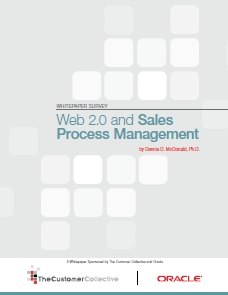Highlights from "Web 2.0 and Sales Process Management"
 Click the above image to download a free copy of the report.Every sales person I know wants better leads. Because of this the benefits of applying Web 2.0 techniques to prospecting and qualifying would seem to be a no-brainer. But what about using Web 2.0 techniques to support other sales processes?
Click the above image to download a free copy of the report.Every sales person I know wants better leads. Because of this the benefits of applying Web 2.0 techniques to prospecting and qualifying would seem to be a no-brainer. But what about using Web 2.0 techniques to support other sales processes?
I explored this question in a recent “white paper” for Social Media Today LLC and Oracle Software. The report (click here to download a .pdf version) includes discussion, analysis, and reports of an online survey and a series of sales manager interviews that looked at all stages of the sales process, not just the front end.
Here is a portion of the report’s Introduction:
This report discusses how “web 2.0” systems and applications can support management of sales processes. Instead of focusing on specific technologies such as social networking, blogs, wikis, or other technologies, it focuses on business processes and addresses the following questions:
How satisfied are sales managers with the different processes currently involved in locating, managing, and closing sales?
What can this tell us about where Web 2.0 applications would provide the most benefit to the overall sales process?
Input to this report was provided by a special online survey and by telephone interviews with sales managers.
The project’s findings include the following:
The most immediate perceived benefits of applying Web 2.0 techniques to sales are provided by improving the outcomes of prospecting and customer qualification.
When addressing Web 2.0 support for sales-related communication and collaboration, it’ important to distinguish whether participants or processes being considered are internal or external to the sales team’s organization. For example, while involvement with the social and professional communities surrounding business prospects may improve market intelligence about business prospects, such communications are not as controllable as traditional one-to-one communications between buyer and sellers. Internally, collaboration that cuts across organizational boundaries might be impacted by existing organizational rivalries.
Some within-sales-force collaboration may be resisted by sales people if this raises fears of reduced competitiveness or shared commissions. To promote such collaboration it may be necessary to modify compensation plans to reward certain types of collaboration.
Sales process maturity may strongly influence adoption of Web 2.0 techniques. Well-defined and formalized processes, such as those that occur closer to the end of the sales cycle, benefit differently than activities that are less structured or performed independently by members of the sales team.
- The lengthier and more complex the sales process, the more participants will be involved as the process evolves. Making information gathered at one stage available to other participants “downstream” will help ensure a smooth transition from sales to delivery and servicing of the customer. Organizational or departmental barriers that restrict collaboration across groups should not be allowed to disrupt the sales process and satisfaction of the customer.
To download a .pdf version of the final version of the report, click here.
To see a follow on post to the above titled “More Thoughts on ‘Web 2.0 and Sales Process Management’” click here.
Copyright (c) 2009 by Dennis D. McDonald, Ph.D.